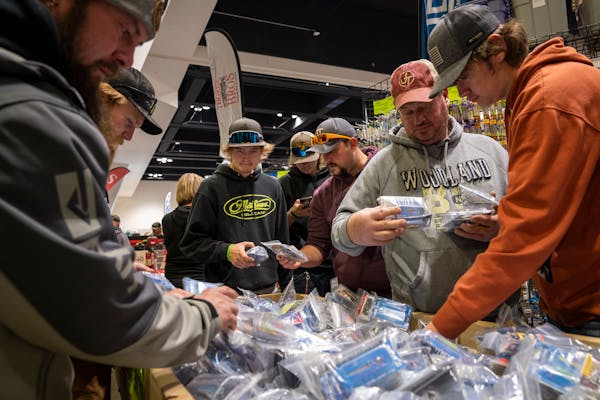A great thing about crappies, from an angler's perspective, is that, in springtime, under the right circumstances, they can be caught fairly readily in shallow water, providing lasting memories on the water and, later, at the dinner table.
But winter crappie fishing is a different story. In the cold months these fish retreat to deep-water basins and hang out there, their locations unknown to many anglers.
So the cycle has repeated itself for a century and more.
But no longer.
Now, thanks to a new and increasingly more affordable fishing gadget called forward-scanning sonar, winter anglers can pinpoint with relative ease the cold-weather hideouts crappies favor.
And, when conditions are right, catch them one after another.
Already crappies are one of Minnesota's most sought-after fish. In one survey, 13% of state anglers said they prefer pursuing crappies more than any other fish. Only walleye fishing (the choice of 20% of anglers) and "fishing for anything that bites" (18%) were more popular.
Realizing the pressure anglers place on crappies, Department of Natural Resources (DNR) fisheries biologists and managers for decades have studied possible ways the state's crappie numbers can be sustained and their sizes increased.
Statewide, officials have lowered the limit to 10, and on some lakes the legal crappie tally is half that.
Still, the "good old days" of crappie fishing seem long past. The number of crappies weighing 1.75 pounds and larger entered in a northern Minnesota fishing contest, for example, dropped from 151 in 1941 to 15 as far back as 1987.
Complicating crappie management still further, winter anglers who find crappies in their deep hideouts often catch and release two, three, four or five for every one they keep.
The anglers' intent is understandable. They want enough crappies, and enough big ones, to take home for a meal.
But crappies retrieved from deep water, though released, often subsequently die from the effects of "barotrauma," which occurs when fish are retrieved through different levels of barometric pressure at different water depths.
Other fish are similarly vulnerable. Walleyes caught in water 25 feet deep or more sometimes die from barotrauma in the hours or days after being released.
"But crappies are fairly unique in that they like to find the deepest part of a lake and hang out over it in winter," said Chris Smith, a DNR fisheries researcher in Glenwood, Minn. "That's one reason we're concerned about them. People have fished crappies in winter in deep water for a long time, but they haven't been able to find these locations as easily as they can now."
To determine the effects of barotrauma on crappies caught at various depths, Smith and other DNR fisheries staff, with help from Lindner's Angling Edge in Brainerd, last winter conducted a study of crappies caught in water depths ranging from 21 feet to 32 feet.
Lakes near Walker, Glenwood and Waterville were selected for the study. Results showed that crappies caught in water about 30 feet deep are extremely vulnerable to barotrauma — even though some didn't show the effects immediately upon being brought to the surface.
"Surprisingly, it didn't seem to matter how slowly we retrieved the crappies from the deep water," Smith said. "The common believe is that if a fish is retrieved slowly from deep water it'll be OK. That often wasn't the case. We put a camera into the water and could see as the crappies got closer to the surface they started to struggle, some by losing their buoyancy."
Fish caught during the project were released into a hoop net that extended to the lake bottom. Many released crappies swam away and headed down — actions that often reassure anglers the fish they've released are unharmed.
"But when we checked the net the next day, 16 of the 50 fish we caught in the deeper water had died and another 22 had suffered the effects of barotrauma and couldn't be released," Smith said.
In the second study lake, 50 crappies were caught in water 16 to 24 feet deep. Forty-eight recovered, and only two couldn't be released.
In the third lake, another 50 crappies were caught in water 22 to 26 feet deep. Forty-six of these fish recovered and four died.
Jon Hansen, a DNR fisheries consultant based in St. Paul, said the study's idea originated with the agency's panfish work group, a statewide citizens advisory council.
Staff from AnglingBuzz broadcasts, a Lindner's Angling Edge production based in Brainerd, helped the DNR conduct the study, Hansen said.
Because it's unlikely forward-scanning sonar will be banned in Minnesota, Smith and Hansen said they hope winter anglers will consider keeping the first crappies they catch, rather than release fish they believe, perhaps mistakenly, might live.
"Anglers might not recognize the effects of barotrauma on fish," Smith said. "But examining crappies closely that were caught, we could see their bulging eyes and their swim bladders extended. Individual fish have different levels of resiliency, and some recover. But some don't."

Anderson: Building a new Waterville fish hatchery will help shorten the time between bites

Anderson: Trailblazing sonar will be in thousands of boats for opener

Anderson: Celebrate Earth Day by rekindling real connection to nature
Anderson: Anglers protesting tough new Mille Lacs rules are wrong



